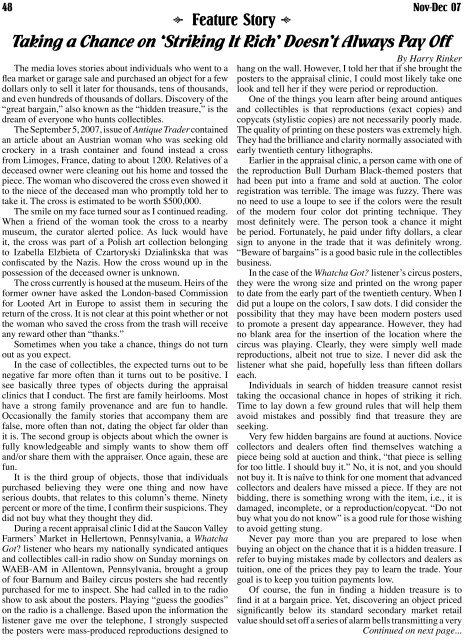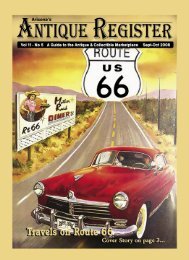The Antique Register
The Antique Register
The Antique Register
You also want an ePaper? Increase the reach of your titles
YUMPU automatically turns print PDFs into web optimized ePapers that Google loves.
48 Nov-Dec 07<br />
� Feature Story �<br />
Taking a Chance on ‘Striking It Rich’ Doesn’t Always Pay Off<br />
<strong>The</strong> media loves stories about individuals who went to a<br />
flea market or garage sale and purchased an object for a few<br />
dollars only to sell it later for thousands, tens of thousands,<br />
and even hundreds of thousands of dollars. Discovery of the<br />
“great bargain,” also known as the “hidden treasure,” is the<br />
dream of everyone who hunts collectibles.<br />
<strong>The</strong> September 5, 2007, issue of <strong>Antique</strong> Trader contained<br />
an article about an Austrian woman who was seeking old<br />
crockery in a trash container and found instead a cross<br />
from Limoges, France, dating to about 1200. Relatives of a<br />
deceased owner were cleaning out his home and tossed the<br />
piece. <strong>The</strong> woman who discovered the cross even showed it<br />
to the niece of the deceased man who promptly told her to<br />
take it. <strong>The</strong> cross is estimated to be worth $500,000.<br />
<strong>The</strong> smile on my face turned sour as I continued reading.<br />
When a friend of the woman took the cross to a nearby<br />
museum, the curator alerted police. As luck would have<br />
it, the cross was part of a Polish art collection belonging<br />
to Izabella Elzbieta of Czartoryski Dzialinkska that was<br />
confiscated by the Nazis. How the cross wound up in the<br />
possession of the deceased owner is unknown.<br />
<strong>The</strong> cross currently is housed at the museum. Heirs of the<br />
former owner have asked the London-based Commission<br />
for Looted Art in Europe to assist them in securing the<br />
return of the cross. It is not clear at this point whether or not<br />
the woman who saved the cross from the trash will receive<br />
any reward other than “thanks.”<br />
Sometimes when you take a chance, things do not turn<br />
out as you expect.<br />
In the case of collectibles, the expected turns out to be<br />
negative far more often than it turns out to be positive. I<br />
see basically three types of objects during the appraisal<br />
clinics that I conduct. <strong>The</strong> first are family heirlooms. Most<br />
have a strong family provenance and are fun to handle.<br />
Occasionally the family stories that accompany them are<br />
false, more often than not, dating the object far older than<br />
it is. <strong>The</strong> second group is objects about which the owner is<br />
fully knowledgeable and simply wants to show them off<br />
and/or share them with the appraiser. Once again, these are<br />
fun.<br />
It is the third group of objects, those that individuals<br />
purchased believing they were one thing and now have<br />
serious doubts, that relates to this column’s theme. Ninety<br />
percent or more of the time, I confirm their suspicions. <strong>The</strong>y<br />
did not buy what they thought they did.<br />
During a recent appraisal clinic I did at the Saucon Valley<br />
Farmers’ Market in Hellertown, Pennsylvania, a Whatcha<br />
Got? listener who hears my nationally syndicated antiques<br />
and collectibles call-in radio show on Sunday mornings on<br />
WAEB-AM in Allentown, Pennsylvania, brought a group<br />
of four Barnum and Bailey circus posters she had recently<br />
purchased for me to inspect. She had called in to the radio<br />
show to ask about the posters. Playing “guess the goodies”<br />
on the radio is a challenge. Based upon the information the<br />
listener gave me over the telephone, I strongly suspected<br />
the posters were mass-produced reproductions designed to<br />
By Harry Rinker<br />
hang on the wall. However, I told her that if she brought the<br />
posters to the appraisal clinic, I could most likely take one<br />
look and tell her if they were period or reproduction.<br />
One of the things you learn after being around antiques<br />
and collectibles is that reproductions (exact copies) and<br />
copycats (stylistic copies) are not necessarily poorly made.<br />
<strong>The</strong> quality of printing on these posters was extremely high.<br />
<strong>The</strong>y had the brilliance and clarity normally associated with<br />
early twentieth century lithographs.<br />
Earlier in the appraisal clinic, a person came with one of<br />
the reproduction Bull Durham Black-themed posters that<br />
had been put into a frame and sold at auction. <strong>The</strong> color<br />
registration was terrible. <strong>The</strong> image was fuzzy. <strong>The</strong>re was<br />
no need to use a loupe to see if the colors were the result<br />
of the modern four color dot printing technique. <strong>The</strong>y<br />
most definitely were. <strong>The</strong> person took a chance it might<br />
be period. Fortunately, he paid under fifty dollars, a clear<br />
sign to anyone in the trade that it was definitely wrong.<br />
“Beware of bargains” is a good basic rule in the collectibles<br />
business.<br />
In the case of the Whatcha Got? listener’s circus posters,<br />
they were the wrong size and printed on the wrong paper<br />
to date from the early part of the twentieth century. When I<br />
did put a loupe on the colors, I saw dots. I did consider the<br />
possibility that they may have been modern posters used<br />
to promote a present day appearance. However, they had<br />
no blank area for the insertion of the location where the<br />
circus was playing. Clearly, they were simply well made<br />
reproductions, albeit not true to size. I never did ask the<br />
listener what she paid, hopefully less than fifteen dollars<br />
each.<br />
Individuals in search of hidden treasure cannot resist<br />
taking the occasional chance in hopes of striking it rich.<br />
Time to lay down a few ground rules that will help them<br />
avoid mistakes and possibly find that treasure they are<br />
seeking.<br />
Very few hidden bargains are found at auctions. Novice<br />
collectors and dealers often find themselves watching a<br />
piece being sold at auction and think, “that piece is selling<br />
for too little. I should buy it.” No, it is not, and you should<br />
not buy it. It is naîve to think for one moment that advanced<br />
collectors and dealers have missed a piece. If they are not<br />
bidding, there is something wrong with the item, i.e., it is<br />
damaged, incomplete, or a reproduction/copycat. “Do not<br />
buy what you do not know” is a good rule for those wishing<br />
to avoid getting stung.<br />
Never pay more than you are prepared to lose when<br />
buying an object on the chance that it is a hidden treasure. I<br />
refer to buying mistakes made by collectors and dealers as<br />
tuition, one of the prices they pay to learn the trade. Your<br />
goal is to keep you tuition payments low.<br />
Of course, the fun in finding a hidden treasure is to<br />
find it at a bargain price. Yet, discovering an object priced<br />
significantly below its standard secondary market retail<br />
value should set off a series of alarm bells transmitting a very<br />
Continued on next page...



